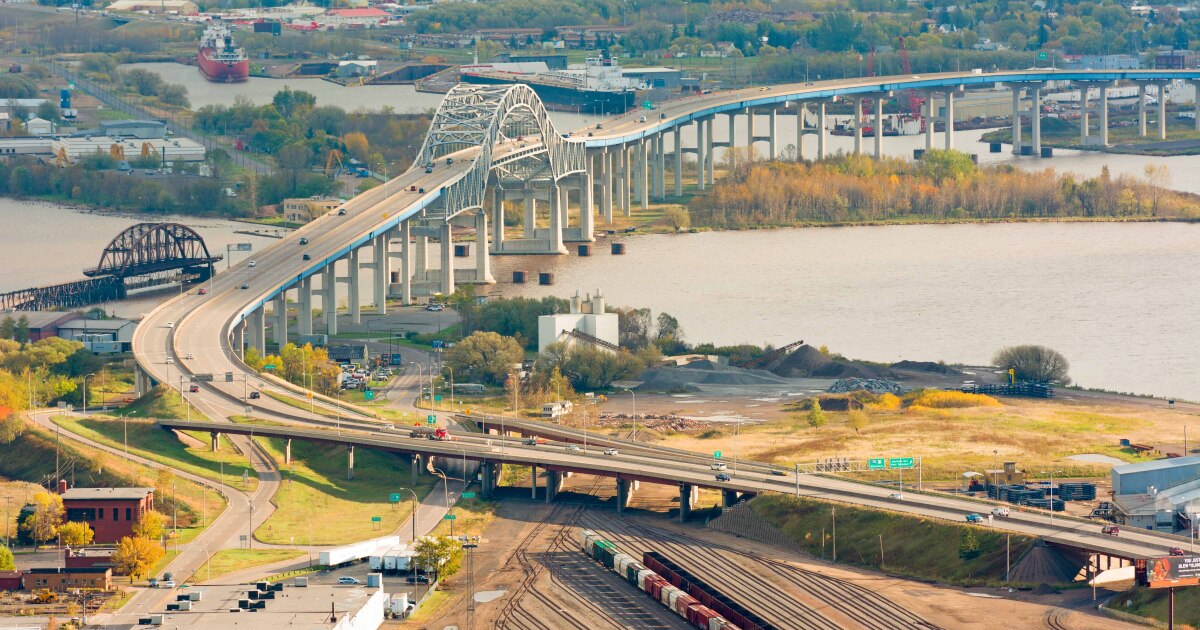Bonds are part of plan to replace key bridge linking Wisconsin, Minnesota
3 min read

The John A. Blatnik Bridge links Superior, Wisconsin to Duluth, Minnesota, curving across the Saint Louis River between the two cities. But over its 62 years, rust and structural decay have taken a toll on the 7,975-feet-long steel span. So the Minnesota and Wisconsin departments of transportation, which co-own and operate the bridge, are planning to replace it.
State bonds are a key part of that plan, but officials in the two states are also seeking more than $1 billion in federal grants to raze the bridge and build anew. While last year’s federal omnibus spending bill included $7.5 million for the bridge, the two states still have a significant gap to fill.
“At this point in time, knowing what we know, the current [total cost estimate] is $1.8 billion in year of expenditure dollars,” said Pat Huston, assistant district engineer, major projects for the Minnesota Department of Transportation. “It will likely change as we know more.”
Adobe Stock
In addition to requesting federal funding — first through the U.S. Department of Transportation’s Multimodal Project Discretionary Grant program, then more recently through the USDOT’s Bridge Investment Program — each state has committed $400 million toward the costs of replacing the bridge.
“About $200 million of that is from our capital highway improvement program, and $200 million will be from bonds,” said Minnesota’s Huston. The latter $200 million will come from trunk highway bonds authorized in the 2023 legislative session.
Minnesota has been
“This project is vital to regional economic growth, strengthening our national supply chains and the reliability of our transportation network that serves hundreds of communities,” said Minnesota DOT District 1 Communications Director Pippi Mayfield.
For its part, Wisconsin authorized $47.2 million in state funds and $352.8 million in general obligation bonding authority toward the project in its 2023-25 budget.
Wisconsin Capital Finance Director Aaron Heintz said the bonds will be issued in state fiscal year 2026, which begins July 1, 2025.
Fitch Ratings assigns Wisconsin a long-term issuer default rating of AA-plus, Moody’s Investors Service rates it Aa1, Kroll Bond Rating Agency rates Wisconsin GOs AAA and S&P Global Ratings assigns the state a rating of AA-plus.
The usage order of funding that includes federal grants is: first, match requirements of the grant with funding in the form of general obligations; next, federal grant funding; and finally, state funding via bonds.
“The state bonding would first satisfy any matching requirements of the federal grant funding, and then would be used after federal grant funding has been exhausted, with state funding providing the last dollars for the project,” Heintz said.
Planning for the project began in August 2020, and now both states are eager to set their plan in motion. In 2019, officials implemented load restrictions on the bridge: trucks weighing more than 40 tons are barred from crossing. And Blatnik may need to be closed completely before 2030 for safety reasons.
Yet today, more than 33,000 cars and trucks traverse the bridge daily.
“I’m proud to partner with Wisconsin Governor Tony Evers as we urge our federal partners to support this project that will foster regional economic growth, bolster our national supply chains, and strengthen the reliability of our transportation network that serves hundreds of communities between our states,” Minnesota Gov. Tim Walz said in a statement.
“These grant applications and deepening shows of support – from local communities and elected officials in both states – demonstrate how important this project is and why we must act with urgency,” added Wisconsin DOT Secretary Craig Thompson.
In
The Wisconsin DOTs estimate phased construction could






